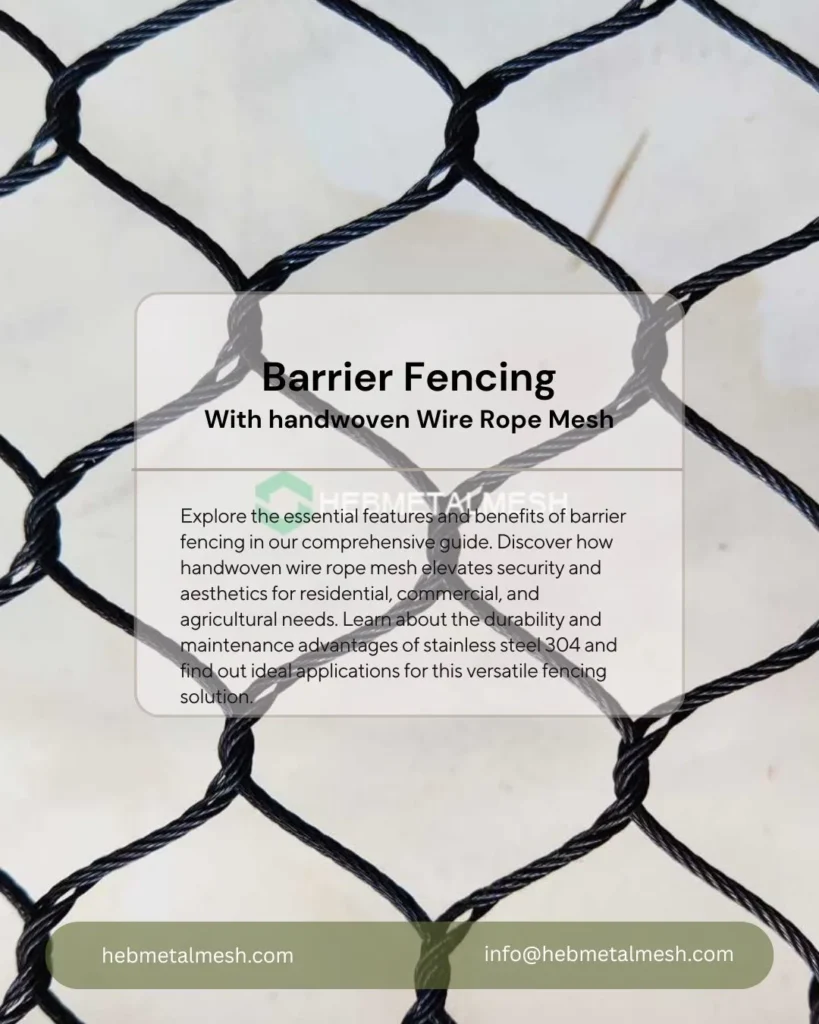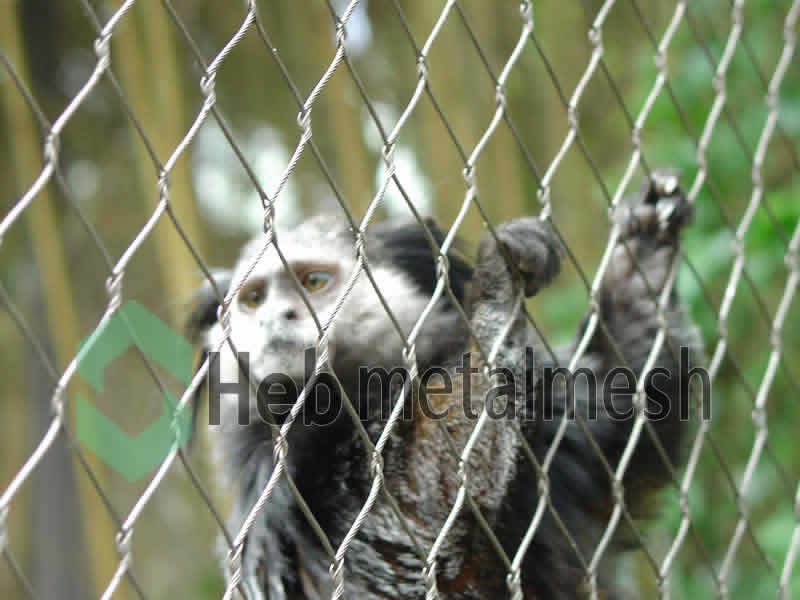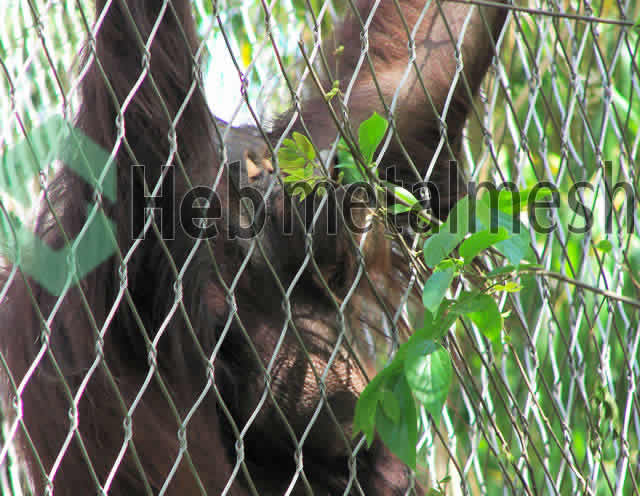Selecting the appropriate animal barrier netting is crucial for protecting crops, livestock, wildlife enclosures, and property from damage while ensuring humane and long-lasting solutions. High-quality stainless steel mesh netting offers superior strength, corrosion resistance, and adaptability for various environments—from agricultural fields to zoo enclosures.
Industry standards, such as those outlined by the International Organization for Standardization (ISO) (ISO 9001:2015 for Quality Management) and wildlife management guidelines from the USDA Animal and Plant Health Inspection Service (APHIS) (Wildlife Damage Management), emphasize the importance of durable and non-harmful barriers. HEBMetal Mesh provides customized netting solutions tailored to specific needs, ensuring compliance with safety and environmental regulations.
Whether for bird control, pest exclusion, or predator deterrence, choosing the right material and design enhances effectiveness while promoting sustainable cohabitation between humans and animals.
Introduction to Animal Barrier Netting
Animal barrier netting serves a crucial function in various environments, such as zoos, wildlife parks, and animal enclosures. This specialized netting is designed to prevent animals from escaping while simultaneously ensuring that they are safe and secure within their habitat. Given its essential role, selecting the appropriate type of animal barrier netting is vital, not only for the protection of the animals but also for the overall aesthetic and natural environment of their surroundings.
The primary purpose of animal barrier netting is to create a safe enclosure that prevents animals from fleeing into potentially dangerous situations while allowing them to exhibit natural behaviors. This product comes in various sizes, materials, and mesh configurations, each tailored to accommodate different species and their specific needs. For example, larger and more agile animals may require thicker and more durable netting to withstand their strength and prevent escape, whereas smaller birds might require finer meshing to ensure they cannot slip through.
Another important consideration when choosing animal barrier netting is maintaining the visual appeal of the habitat. Many enclosures aim to replicate a natural environment, where the animals can thrive and be observed without the intrusive barriers that traditional fencing can impose. The right netting allows for unobstructed views, enabling visitors to appreciate the wildlife while ensuring that the animals remain safe and securely contained. Additionally, the selection process requires careful evaluation of the netting’s durability, ease of installation, and maintenance requirements to ensure it meets both aesthetic and functional needs.
Benefits of Using Stainless Steel Rope Mesh
Stainless steel rope mesh is increasingly becoming the material of choice for animal barrier netting, offering numerous benefits that make it an exceptional investment for animal enclosures. One of the primary advantages of stainless steel rope mesh is its remarkable durability. Unlike other materials that may wear out or degrade over time, stainless steel is engineered to withstand harsh environmental conditions. This resilience ensures that the netting maintains its structural integrity, providing reliable protection for animals over an extended period.
Additionally, the corrosion resistance of stainless steel is a significant factor in its favor. Traditional materials, such as standard steel or plastic, can succumb to rust and deterioration when exposed to moisture, chemicals, and UV rays. In contrast, stainless steel rope mesh remains unaffected by these elements, ensuring longevity and reducing maintenance costs. This quality is especially important in regions with unpredictable weather patterns, where durability is vital for effective animal barrier solutions.
Another notable benefit of stainless steel rope mesh is its aesthetic appeal. The open design of the mesh allows for unobstructed views, showcasing the beauty of the surrounding environment while maintaining safety. This visual aspect is particularly advantageous for settings such as zoos and parks, where both the animals and the visitors can enjoy an uninterrupted experience. Additionally, stainless steel netting provides a professional and modern appearance, which can enhance the overall design of an enclosure.
In conclusion, the advantages of utilizing stainless steel rope mesh for animal barrier netting are clear. Its durability, corrosion resistance, and aesthetic qualities make it a preferred choice, especially when sourced from reputable manufacturers like Hebmetalmesh. This combination of features ensures that animal enclosures are both functional and visually pleasing, providing peace of mind to animal caretakers and enhancing the overall experience for all. Choosing the right material is crucial for any animal enclosure, and stainless steel rope mesh stands out as an optimal solution.
Key Factors to Consider When Choosing Netting Fence
Selecting the appropriate animal barrier netting is a critical decision that requires careful consideration of several key factors. These factors ensure that the chosen netting not only meets your immediate needs but also provides long-term effectiveness and durability. Understanding the type of animals you aim to keep contained is paramount. Different species have varying levels of strength and agility, which might require specific types of netting to effectively restrain them. For instance, lightweight netting may be suitable for smaller animals, while larger, stronger animals may necessitate a more robust material.
The environment in which the animal barrier will be implemented is another significant factor. If the netting will be placed in areas with a high likelihood of weather extremes — be it strong winds, heavy rains, or intense sunshine — it is essential to choose netting materials that can withstand these conditions. Certain netting options are designed to be UV resistant, preventing deterioration due to sun exposure, while others might be reinforced to endure high-stress situations.
Maintenance is also a crucial consideration that often gets overlooked. Some types of animal barrier netting require regular upkeep to remain effective, while others are designed to be low-maintenance. Knowing your commitment to maintenance can help in selecting a netting solution that best fits your lifestyle and needs. Additionally, consider the ease of installation. Some netting options come with straightforward installation guidelines, while others may require more complex setup procedures.
In evaluating these factors, you can make a more informed decision about the type of animal barrier netting best suited to your circumstances. By thoroughly considering your specific needs, you can ensure that the netting will be effective and efficient in protecting your space from unwanted animal intrusion.
Hebmetalmesh: A Trusted Manufacturer
Hebmetalmesh has established itself as a reputable manufacturer in the field of stainless steel netting suitable for various applications, including animal barrier netting. With years of experience in the industry, the company has consistently demonstrated a commitment to quality and innovation. Their expertise in designing and fabricating high-performance netting solutions ensures that customers receive products that are not only durable but also effective in serving their intended purpose.
The quality of products offered by Hebmetalmesh is one of the key factors contributing to its outstanding reputation. Their stainless steel animal barrier netting is engineered using the finest materials, which enhances its strength and performance in various environmental conditions. The netting is designed to withstand the elements while providing a reliable barrier against animals. Furthermore, each product undergoes rigorous quality assurance checks to guarantee that it meets the highest industry standards, ensuring that customers receive a dependable solution for their needs.
Testimonials from satisfied customers further underscore Hebmetalmesh’s credibility as a trusted manufacturer. Many users have reported significant improvements in their animal management strategies after installing the company’s netting solutions. Customers commend the product’s durability and effectiveness in deterring unwanted wildlife and livestock. Positive feedback often highlights the ease of installation and maintenance of the netting, making it a preferred choice for both residential and commercial applications. As a result, Hebmetalmesh has become a go-to resource for those seeking reliable animal barrier netting solutions, gaining loyal clientele across various sectors.
By choosing Hebmetalmesh, customers can be assured of collaborating with a manufacturer that prioritizes quality, reliability, and customer satisfaction in their animal barrier netting offerings.
Applications of Animal Barrier Netting in Zoos and Bird Parks
Animal barrier netting plays a crucial role in zoos and bird parks, enhancing the safety and well-being of both animals and visitors. This specialized netting is designed to manage interactions between species, prevent escapes, and minimize the risk of injury. In particular, zoos utilize heavy-duty netting to reinforce enclosures that house large mammals, ensuring they remain within designated areas while allowing full visibility for spectators. For example, a prominent zoo in California employed animal barrier netting to create secure habitats for their primate exhibits. The netting not only protected the animals from potential threats but also provided a visually appealing environment where visitors could observe natural behaviors.
In addition to large mammals, bird parks benefit significantly from the use of animal barrier netting. The lightweight yet durable material is ideal for aviaries where the primary goal is to allow free flight while safeguarding birds from external predators. A bird park in Florida recently upgraded its aviary with animal barrier netting, successfully minimizing bird fatalities while enhancing visitor experiences. The transparency of the netting provides an unobstructed view of the birds while ensuring they have the space they need to thrive.
Furthermore, the adaptability of animal barrier netting means it can be customized to fit various environments, whether covering large expanses or smaller enclosures. This flexibility is beneficial for both new constructions and retrofitting existing habitats. With its ability to blend into different settings, animal barrier netting ensures that zoos and bird parks can prioritize the welfare of the animals while maintaining an attractive aesthetic. As such, these facilities are increasingly relying on this effective solution to enhance their animal enclosures while fostering educational experiences for visitors.
Installation Process of Animal Barrier Netting
When considering the installation of animal barrier netting, it is essential to evaluate both DIY approaches and the option of hiring professionals. Each method has its benefits, and your choice may depend on your budget, skills, and the complexity of the installation site. For those opting for a DIY installation, the first step is to measure the area to determine how much netting is required. It is crucial to select the appropriate type of netting that suits the specific animals you intend to deter. High-quality animal barrier netting should be durable, UV resistant, and able to withstand various weather conditions.
Once you have acquired the necessary materials, including the animal barrier netting, stakes, and tools, prepare the site by clearing any debris or vegetation that could interfere with the installation. Next, begin by anchoring the netting at one corner of the designated area, ensuring it is taut and securely affixed. Proper tension is vital, as loose netting can allow animals to slip through, defeating its purpose. Continue to stake down the netting at regular intervals, maintaining a straight line to enhance both security and aesthetics.
Alternatively, if you decide to hire professionals for the installation, you can benefit from their expertise in securing the netting effectively. Professionals will often have advanced techniques and tools at their disposal, ensuring that the installation meets safety standards while providing a visually appealing result. Regardless of the approach you choose, it is important to periodically check the netting for any wear and tear, and to perform maintenance as needed. This will further ensure the longevity of the animal barrier netting and protect your property from unwanted wildlife intrusion.
Maintenance and Care for Stainless Steel Netting
When investing in animal barrier netting made from stainless steel, it is crucial to implement a regular maintenance routine to ensure its longevity and optimal functionality. Stainless steel netting is valued for its strength, durability, and resistance to corrosion, making it an excellent choice for both residential and commercial applications. However, maintaining it requires some attention to detail and periodic care.
One of the first steps in caring for stainless steel netting is cleaning. Over time, debris, dust, and organic matter can accumulate on the mesh, potentially compromising its integrity and aesthetic appeal. Utilize a soft brush or cloth and a mixture of mild soap and warm water to gently scrub the surface. Rinse thoroughly with clean water to remove any soap residue. This routine cleaning should be performed at least once a season or more frequently in areas with high debris exposure.
Inspections for wear and tear should also be conducted during maintenance sessions. Examine the animal barrier netting for any signs of damage, including fraying or rust spots. If any discrepancies are found, they should be addressed promptly to prevent further deterioration. Tightening loose fittings and replacing worn sections of netting will contribute to its overall performance, thereby safeguarding against unwanted animal intrusions.
Seasonal maintenance tasks are equally important. In colder climates, consider removing or securing the netting during extreme weather conditions to prevent stress caused by ice and snow accumulation. Conversely, during warmer months, ensure there are no obstructions such as overgrown vegetation that could hinder the netting’s ability to serve its purpose effectively.
By routinely cleaning, inspecting, and maintaining stainless steel animal barrier netting, property owners can extend its lifespan and preserve its functionality for many years to come.
Comparing Cost: Stainless Steel vs. Other Materials
When selecting animal barrier netting, cost is a crucial factor influencing the decision-making process. Among the various options available, stainless steel rope mesh often presents a higher initial investment compared to other materials such as plastic, vinyl, or nylon. However, understanding the long-term implications of these costs can provide a clearer picture of value.
Stainless steel netting typically offers superior durability and resistance to environmental conditions, which can translate to a longer lifespan. In contrast, alternatives like plastic or nylon may present lower upfront costs but can succumb to wear and tear more quickly. For instance, UV exposure, temperature fluctuations, and physical stress can lead to degradation in non-metal materials, resulting in the need for frequent replacements or repairs. Thus, while the initial expenditure for stainless steel might be daunting, its longevity can lead to cost savings over time.
Furthermore, it is important to consider installation costs. Stainless steel animal barrier netting, due to its strength, can often be installed with less support than weaker materials, potentially reducing installation labor costs. Conversely, weaker alternatives may require additional brackets or supports to maintain structural integrity, thus increasing total expenses. When evaluating the total cost-effectiveness of various materials, factors such as maintenance, replacement frequency, and installation intricacies should be factored in.
In conclusion, while stainless steel rope mesh often reflects a higher initial price tag, its long-term benefits should be weighed carefully against those of alternative netting materials. By analyzing durability, maintenance, and installation, stakeholders can make an informed choice that balances both immediate costs and future savings.
Conclusion: Making the Right Choice for Animal Safety
In conclusion, selecting the appropriate animal barrier netting is imperative for ensuring the safety and security of both wildlife and domestic animals. The right netting serves to protect animals from potential dangers while also safeguarding gardens, crops, and property from wildlife intrusion. As discussed throughout this guide, factors such as material strength, mesh size, and the specific type of animals you aim to exclude or contain should heavily influence your choice.
When considering animal barrier netting, it is crucial to opt for materials that provide both durability and visibility. Options such as polyethylene and galvanized wire offer varying benefits, with some providing added UV resistance and others enhanced strength ideal for larger animals. Furthermore, choosing the correct mesh size is vital; a finer mesh can prevent smaller animals from passing through but must still maintain a balance to ensure larger animals cannot compromise its integrity.
Beyond functionality, aesthetics should not be overlooked. The design and color of the barrier can affect not only the appearance of your property but also the psychological impact on the animals. A well-designed netting not only fulfills its functional purpose but also complements the surrounding environment, fostering a harmonious coexistence between animals and human habitats.
Ultimately, informed decision-making, guided by a comprehensive understanding of different types of animal barrier netting and their respective benefits, is essential. Take the time to evaluate your specific needs, and consider the information outlined in this guide as you make your choice. By doing so, you can ensure a safe and efficient solution that meets both your requirements and those of the animals within your care.


